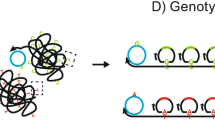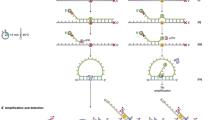Abstract
Recently, a polymorphic base in exon 13 of the BCR gene (exon b2 of the major breakpoint cluster region) has been identified in the eighth position before the junctional region of BCR-ABL cDNA. Cytosine replaces thymidine; the corresponding triplets are AAT (T allele) and AAC (C allele), respectively, both coding for asparagine. Therefore, this polymorphism has no implication in the primary structure of BCR and BCR-ABL proteins. However, since the alteration is located close to the fusion region it may have a significant influence on the annealing of PCR primers, probes for real time PCR, and antisense oligonucleotides. We have developed a RT-PCR-based screening method to easily identify polymorphic BCR and BCR-ABL alleles in CML patients and normal individuals in order to estimate their frequency. After amplification from cDNA, a melting curve of a specific fluorogenic probe mapping to the 3′ end of BCR exon b2 and spanning the polymorphism readily discriminates between normal and polymorphic BCR and BCR-ABL alleles. This reporter probe is 3′ labeled with fluorescein and placed next to 5′ LC Red640-labeled anchor probes mapping to the 5′ ends of BCR exon b3 or ABL exon a2 so that resonance energy transfer occurs when the probes are hybridized (LightCycler technology). T and C alleles were discriminated by a melting temperature difference of the reporter probe of 3.2 K. We have investigated cDNAs derived from leukocytes from seven cell lines and a total of 229 individuals: normal donors, n = 15; BCR-ABL negative chronic myeloproliferative disorders, n = 30; BCR-ABL negative acute leukemias, n = 11; b2a2BCR-ABL positive CML, n = 93; and b3a2BCR-ABL positive CML, n = 80. The frequency of the C allele was 33.0% in BCR-ABL negative individuals, 30.6% in b2a2BCR-ABL, and 23.8% in b3a2BCR-ABL positive CML. In CML patients, 27.7% of BCR-ABL and 27.2% of BCR alleles had the C allele (NS). In total, 132 of 458 (28.8%) exons b2 of BCR or BCR-ABL alleles demonstrated this polymorphism. We conclude that a thymidine/cytosine replacement occurs frequently in BCR exon b2. Probes for real time quantitative RT-PCR should be designed not to map to the critical region in order to avoid underestimation of the number of BCR-ABL transcripts.
This is a preview of subscription content, access via your institution
Access options
Subscribe to this journal
Receive 12 print issues and online access
$259.00 per year
only $21.58 per issue
Buy this article
- Purchase on Springer Link
- Instant access to full article PDF
Prices may be subject to local taxes which are calculated during checkout



Similar content being viewed by others
References
Heisterkamp N, Stam K, Groffen J, de Klein A, Grosveld G . Structural organization of the bcr gene and its role in the Ph′ translocation Nature 1985 315: 758–761
Chissoe SL, Bodenteich A, Wang YF, Wang YP, Burian D, Clifton SW, Crabtree J, Freeman A, Iyer K, Jian L, Ma Y, McLaury HJ, Pan HQ, Sarhan OH, Toth S, Wang Z, Zhang G, Heisterkamp N, Groffen J, Roe BA . Sequence and analysis of the human ABL gene, the BCR gene, and regions involved in the Philadelphia chromosomal translocation Genomics 1995 27: 67–82
Rosenblum-Vos LS, Griffin CA . Identification of a BCR polymorphism in a bone marrow donor: diagnostic implications Leukemia 1998 12: 1499–1500
Reiter A, Skladny H, Hochhaus A, Seifarth W, Heimpel H, Bartram CR, Cross NCP, Hehlmann R . Molecular response of CML patients treated with interferon-α monitored by quantitative Southern blot analysis Br J Haematol 1997 97: 86–93
Hochhaus A, Weisser A, La Rosée P, Emig M, Müller MC, Saußele S, Reiter A, Kuhn C, Berger U, Hehlmann R, Cross NCP . Detection and quantification of residual disease in chronic myelogenous leukemia Leukemia 2000 14: 998–1005
Thijsen SFT, Schuurhuis GJ, van Oostveen JW, Ossenkoppele GJ . Chronic myeloid leukaemia from basics to bedside Leukemia 1999 13: 1646–1674
Melo JV . The molecular biology of chronic myeloid leukaemia Leukemia 1996 10: 751–756
de V Meissner R, Dias PMB, Covas DT, Job F, Leite M, Nardi NB . A polymorphism in exon b2 of the major breakpoint cluster region (M-bcr) identified in chronic myeloid leukaemia patients Br J Haematol 1998 103: 224–226
Emig M, Saussele S, Wittor H, Weisser A, Reiter A, Willer A, Berger U, Hehlmann R, Cross NCP, Hochhaus A . Accurate and rapid analysis of residual disease in patients with CML using specific fluorescent hybridization probes for real time quantitative RT-PCR Leukemia 1999 13: 1825–1832
Eckert C, Landt O, Taube T, Seeger K, Beyermann B, Proba J, Henze G . Potential of LightCycler technology for quantification of minimal residual disease in childhood acute lymphoblastic leukemia Leukemia 2000 14: 316–323
Eder M, Battner K, Kafert S, Stucki A, Ganser A, Hertenstein B . Monitoring of BCR-ABL expression using real-time RT-PCR in CML after bone marrow or peripheral blood stem cell transplantation Leukemia 1999 13: 1383–1389
Preudhomme C, Révillion F, Merlat A, Hornez L, Roumier C, Duflos-Grardel N, Jouet JP, Cosson A, Peyrat JP, Fenaux P . Detection of BCR-ABL transcripts in chronic myeloid leukemia (CML) using a ‘real time’ quantitative RT-PCR assay Leukemia 1999 13: 957–964
Branford S, Hughes TP, Rudzki Z . Monitoring chronic myeloid leukaemia therapy by real-time quantitative PCR in blood is a reliable alternative to bone marrow cytogenetics Br J Haematol 1999 107: 587–599
Kronenwett R, Haas R, Sczakiel G . Kinetic selectivity of complementary nucleic acids: bcr/abl-directed antisense RNA and ribozymes J Mol Biol 1996 259: 632–644
Clark RE . Antisense therapeutics in chronic myeloid leukaemia: the promise, the progress and the problems Leukemia 2000 14: 347–355
Ririe KM, Rasmussen RP, Wittwer CT . Product differentiation by analysis of DNA melting curves during the polymerase chain reaction Anal Biochem 1997 245: 154–160
Cross NCP, Feng L, Bungey J, Goldman JM . Minimal residual disease after bone marrow transplant for chronic myeloid leukaemia detected by the polymerase chain reaction Leuk Lymphoma 1993 11: (Suppl. 1) 39–43
Cross NCP, Melo JV, Feng L, Goldman JM . An optimized multiplex polymerase chain reaction (PCR) for detection of BCR-ABL fusion mRNAs in haematological disorders Leukemia 1994 8: 186–189
Schütz E, von Ahsen N . Spreadsheet software for thermodynamic melting point prediction of oligonucleotide hybridization with and without mismatches Biotechniques 1999 27: 1218–1224
Neoh SH, Brisco MJ, Firgaira FA, Trainor KJ, Turner DR, Morley AA . Rapid detection of the factor V Leiden (1691G>A) and haemachromatosis (8456>A) mutation by fluorescence resonance energy transfer (FRET) and real time PCR J Clin Pathol 1999 52: 766–769
Bernard PS, Ajioka RS, Kushner JP, Wittwer CT . Homogeneous multiplex genotyping of hemochromatosis mutations with fluorescent hybridization probes Am J Pathol 1998 153: 1055–1061
Aslanidis C, Nauck M, Schmitz G . High-speed detection of the two common α1-antitrypsin deficiency alleles Pi*Z and Pi*S by real-time fluorescence PCR and melting curves Clin Chem 1999 45: 1872–1875
Herrmann MG, Dobrowolski SF, Wittwer CT . Rapid β-globin genotyping by multiplexing probe melting temperature and color Clin Chem 2000 46: 425–428
van Ahsen N, Schütz E, Armstrong VW, Oellerich M . Rapid detection of prothrombotic mutations of prothrombin (G20210A), Factor V (G1691A), and Methylentetrahydrofolate reductase (C677T) by real-time fluorescence PCR with the LightCycler Clin Chem 1999 45: 694–696
Aslanidis C, Nauck M, Schmitz G . High-speed prothrombin G-A 20210 and methylenetetrahydrofolate reductase C-T 677 mutation detection using real-time fluorescence PCR and melting curves Biotechniques 1999 27: 234–238
Aoshima T, Sekido Y, Miyazaki T, Kajita M, Mimura S, Watanabe K, Shimokata K, Niwa T . Rapid detection of deletion mutations in inherited metabolic diseases by melting curve analysis with LightCycler Clin Chem 2000 46: 119–122
Mensink E, van de Locht A, Schattenberg A, Linders E, Schaap N, Guerts van Kessel A, de Witte T . Quantitation of minimal residual disease in Philadelphia chromosome positive chronic myeloid leukaemia patients using real-time quantitative RT-PCR Br J Haematol 1998 102: 768–774
Szczylik C, Skorski T, Nicolaides NC, Manzella L, Malaguarnera L, Venturelli D, Gewirtz AM, Calabretta B . Selective inhibition of leukemia cell proliferation by BCR-ABL antisense oligodeoxynucleotides Science 1991 253: 562–565
De Fabritiis P, Skorski T, de Propris MS, Paggi MG, Nieborowska-Skorska M, Lisci A, Buffolino S, Campbell K, Geiser T, Calabretta B . Effect of bcr-abl oligodeoxynucleotides on the clonogenic growth of chronic myelogenous leukaemia cells Leukemia 1997 11: 811–819
Kearney P, Wright LA, Milliken S, Biggs JC . Improved specificity of ribozyme-mediated cleavage of bcr-abl mRNA Exp Hematol 1995 23: 986–989
Kronenwett R, Steidl U, Kirsch M, Sczakiel G, Haas R . Oligodeoxyribonucleotide uptake in primary human hematopoietic cells is enhanced by cationic lipids and depends on the hematopoietic cell subset Blood 1998 91: 852–862
De Fabritiis P, Petti MC, Montefusco E, de Propris MS, Sala R, Bellucci R, Mancini M, Lisci A, Bonetto F, Geiser T, Calabretta B, Mandelli F . BCR-ABL antisense oligodeoxynucleotide in vitro purging and autologous bone marrow transplantation for patients with chronic myelogenous leukemia in advanced phase Blood 1998 91: 3156–3162
Smetsers TF, Skorski T, van de Locht LT, Wessels HM, Pennings AH, de Witte T, Calabretta B, Mensink EJ . Antisense BCR-ABL oligonucleotides induce apoptosis in the Philadelphia chromosome-positive cell line BV173 Leukemia 1994 8: 129–140
Acknowledgements
Our study was supported by grants from the Deutsche José-Carreras-Stiftung eV, the Tumorzentrum Mannheim/ Heidelberg, the Forschungsfonds der Fakultät für Klinische Medizin Mannheim, Germany, and by Roche Diagnostics, Mannheim, Germany. Cell lines BV173, K562, and HL60 were bought from the Deutsche Sammlung für Mikroorganismen und Zellkulturen (DSMZ), Braunschweig, Germany, cDNA from cell lines KCL22, LAMA84, and KG1a was kindly provided by Dr Junia V Melo, Imperial College School of Medicine, London, UK.
Author information
Authors and Affiliations
Rights and permissions
About this article
Cite this article
Saußele, S., Weißer, A., Müller, M. et al. Frequent polymorphism in BCR exon b2 identified in BCR-ABL positive and negative individuals using fluorescent hybridization probes. Leukemia 14, 2006–2010 (2000). https://doi.org/10.1038/sj.leu.2401929
Received:
Accepted:
Published:
Issue Date:
DOI: https://doi.org/10.1038/sj.leu.2401929
Keywords
This article is cited by
-
Chronic myeloid leukemia: the concepts of resistance and persistence and the relationship with the BCR-ABL1 transcript type
Leukemia (2019)
-
Serial minimal residual disease (MRD) analysis as a predictor of response duration in Philadelphia-positive acute lymphoblastic leukemia (Ph+ALL) during imatinib treatment
Leukemia (2003)
-
Detection of minimal residual disease in hematologic malignancies by real-time quantitative PCR: principles, approaches, and laboratory aspects
Leukemia (2003)
-
Standardization and quality control studies of ‘real-time’ quantitative reverse transcriptase polymerase chain reaction of fusion gene transcripts for residual disease detection in leukemia – A Europe Against Cancer Program
Leukemia (2003)



